Switches, etc.) during automation pumping units apply special devices monitoring and control, for example, level control relays, jet relays, etc.
Level control relays regulate the operation of pump starters and valves to control fluid levels. Such devices are capable of maintaining a set water level in containers.
Modern liquid level control relays are electronic devices, most often modular, that receive signals from sensors, process them according to a specific algorithm and switch actuators connected to the output contacts of the relay ( solenoid valves, electric motors of pumps).
Since the maximum switched current of the output circuits of electronic level control relays usually does not exceed 10 A, then for switching powerful loads. In this system, the level relay controls the starter coil, and the starter controls the actuators of the pumping unit with its power contacts.
Electronic level control relays work with electrode and float sensors, pressure gauges, radioactive sensors, etc.
Electrode level sensor
Used to monitor the level of electrically conductive liquids. Operating principle: control of water resistance between single-pole immersed electrodes, for which alternating voltage is used.
Consists of one small electrode and two long electrodes mounted in a terminal box. One small electrode is the contact of the upper water level, and the long ones are the contact of the lower water level. The sensor is connected to the level relay and to the pump motor control circuit using wires.
If water comes into contact with the small electrode, the pump starter is turned off. When the level drops to the long electrodes, the pump turns on.
Used to control the water level in non-aggressive liquids. A float is immersed in an open container, suspended on a flexible cable and balanced with a load. Two switching supports are attached to the cable, with the help of which, at maximum water levels in the tank, the rocker arm of the contact device rotates. This rocker closes contacts that turn the pump motor on or off.
In the case of a closed container, the float is connected by its lever to the axis of the lever. An axis with a certain seal is passed into the space through the wall of the housing where the contact part of the sensor is located. The wires from the contacts are routed through the wall of the container.
In most cases, suitable sensors are included with a level switch. After purchasing such a set, the consumer only needs to connect and configure everything correctly.
Relay RKU-1M- controls the liquid level and is used in automatic control of filling and draining containers and in protection circuits. Main characteristics: maximum switching power 3.5 W, power supply 220V, number of sensors 3, one switching contact, maximum distance from sensor to relay 100 m.

Rice. 1. Relay RKU-1M
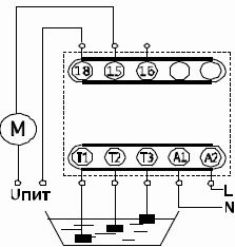
Rice. 2. Connection diagram of the pump to RKU-1M
Water level switch ROS-301- controls three levels of electrically conductive liquids through three independent channels in one or different containers.

Rice. 3. Relay ROS-301
Single-level water level relay PZ-828- has adjustable sensitivity, voltage - 230V, maximum current of output circuits - 16A. The device uses a changeover contact.

Rice. 4. Relay PZ-828
![]()

Two level relay PZ-829 is an automatic machine with adjustable sensitivity. This electronic device can control the presence of liquid at two levels.
Three level relay PZ-830- controls and maintains the set level of conductive liquid by controlling the electric motor of the pumping unit. A three-level automatic machine is capable of monitoring the presence of liquid at three levels, where the third level is emergency.
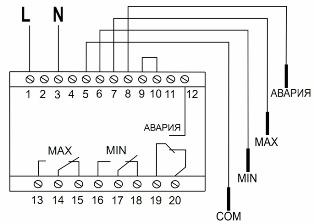
Rice. 6. Connection diagram for four-level level relay PZ-830
Four level relay PZ-832- controls and maintains the level of conductive liquids in tanks, water towers, swimming pools, etc. by controlling electric motors of pumps.
Liquid level switch equipped with three sensors EBR-1- electronic modular relay with a maximum distance between sensors of 100 meters. It can be used for public reservoirs (controlling the filling and draining of a container or well). Sensors supplied with a liquid level control relay are connected to the mechanism.
Main characteristics: power 3.5 VA, three sensors, maximum sensitivity 50 KOhm, power supply 230 V, working temperature-100С - +450С, protection IP20.
Level relay EBR-1
Relay equipped with six sensors EBR-2- a specially designed modular control relay used in wells and tanks. Also, this relay has many settings, notification when the minimum and maximum water levels are reached, the sensors are highly sensitive to the electrical conductivity of the liquid.
The kit includes six sensors. Due to the cost, this monitoring relay is ideal option for modern water level control.
Pumping units used to normalize the water supply have a certain warranty period, but to extend it, it is advisable to use automatic control of the water pump. Such equipment is an installation that prevents damage to the injection device when the water level in the source is insufficient.
If a pumping substation operates without an appropriate sensor, the risk of its failure increases, since it is not designed to operate “dry”. When there is a shortage of fluid, equipment begins to deteriorate and burn out. If you install a water level sensor, you can prevent such troubles. This article is devoted to solving the issue of choice protective device, its operating principle and features.
Selection of relays for protection pumping station idling and maintaining the optimal water level at home requires no less attention than. First of all, you should take into account the characteristics of your own well, and also use indirect advice:
- installation should be convenient and accessible. Therefore, you should not purchase too massive installations. They must also correspond to the characteristics of the pump itself;
- ideal if your sensor has a simplified automatic adjustment. In other words, the device has the ability to independently disconnect from the network until the water in the well returns to its previous level;
- Make sure that the protective relay is well waterproofed, since moisture entering the housing will damage the mechanism if the liquid level increases;
- Check with the seller to see how durable and reliable the pump part is. It wouldn’t hurt to find out how frequent loss of water level in a well affects the operation of the protection;
- the price must match optimal parameters regardless of the manufacturer. Cost may vary due to different pressure ranges and general technical characteristics.
Important! If you made the right choice and installation, the relay will be able to independently stop the device without harm to the working mechanism of the pumping equipment.
Working mechanism of the sensor. How does the design behave when turned on?
A conventional pump idle relay is set to operate at a pressure in the range from 1 to 8 bar, and is oriented according to the liquid level. The internal mechanism of the sensor is a unit with tuned springs that are responsible for two-way pressure limits. They are adjusted with specially installed nuts. The pressure indicator is controlled by a membrane plate, with the help of which the spring is weakened at minimum pressure and tightened when the maximum value is reached.
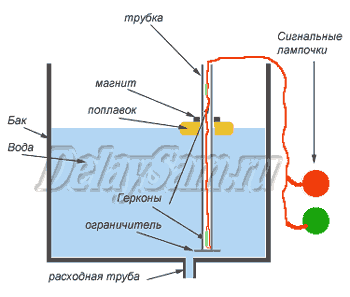
The pressure sensor spring is activated when the circuit contacts open and close. If the pressure drops, the contacts close, which is carried out by the protection sensor and the pump comes into working position. Otherwise, the pump turns off and does not operate until the pressure normalizes to optimal levels.
To set up correct work sensor, you will need a pump control circuit. In order to fine-tune it, it is necessary to bring the pumping unit into working condition - this will increase the water pressure in the well. The operation of the installation can be adjusted using specially located screws under the cover, which protects the sensor automation.
You can independently set the operating limits of the protective device. To do this, perform the following steps sequentially.

- We fix the maximum and minimum pressure limits based on the liquid level in the container at which the pump is in operating condition. Be sure to take readings from the pressure gauge.
- We disconnect the pumping unit from electricity and disassemble the protective device.
- Remove the housing cover and slightly loosen the nut holding the small spring.
- Then we set the minimum pressure: we tighten or release the large spring, also using the locking nut.
- We open the tap to reduce the pressure in the pipeline system. At the same time, do not forget to monitor the operation of the pump.
- We pay attention to the readings of the pressure gauge, if they are optimal for your case, we leave the relay in this state, if not, we adjust it further.
Attention! When setting up the idle speed control sensor, you must take into account the capabilities of the pumping unit. For example, if its factory value with losses is about 3.5 bar, the relay needs to be set to 3 bar. Otherwise, there is a risk of equipment overload.
A few words about automatic water pump control
Devices based on the “automatic” circuit can be useful at home and on the farm. The presence of such equipment is especially important in systems where control of water level and pressure is required.
Sensors based on automatic scheme controls are considered useful and do not require constant monitoring of the equipment of a well, well or other source of water supply. Also, such designs are often used multifunctionally.
Pay attention to the diagram automatic control pump, it is in no way connected with the common reservoir from where water flows through the pump.
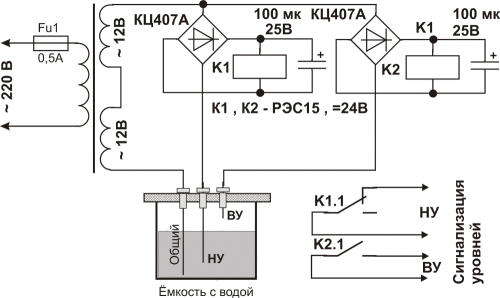
Many of us, and not only avid summer residents, have faced the problem of automation and control of filling containers with water. Most likely, this article is specifically for those who decided to make a simple scheme for monitoring the filling of a container in living conditions. The most cost-effective way to build automation is to use a water control relay. Level control relays (water) are also used in more complex systems water supply of private houses, but in this article we will consider only budget models of relays for monitoring the level of conductive liquid. Controlled liquids include: water (tap, spring, rain), liquids with low alcohol content (beer, wine, etc.), milk, coffee, wastewater, liquid fertilizers. The rated current of the relay contacts is 8-10A, which allows you to switch small pumps without using an intermediate relay or contactor, but manufacturers still recommend installing intermediate relays or contactors to turn pumps on/off. The operating temperature range of the devices is from -10 to +50C, and the maximum possible wire length (from the relay to the sensor) is 100 meters, there are LED operation indicators on the front panel, weight no more than 200 grams, DIN-rail mounting, so you will need to think about it in advance placement of the control system.
The principle of operation of the relay is based on measuring the resistance of the liquid located between two immersed sensors. If the measured resistance is less than the response threshold, then the state of the relay contacts changes. To avoid electrolytic effect alternating current flows across the sensors. The sensor supply voltage is no more than 10V. Power consumption no more than 3W. Fixed sensitivity 50 kOhm.
There are many relays of the same type on the market; let’s consider the most budget models from the manufacturers “Relay and Automation” in Moscow and new products from “TDM” (Morozov Trading House).
Level control relay. ( analogue of RKU-02 TDM)

The TDM level control relay is available in four models:
- (SQ1507-0002) for connector Р8Ц (SQ1503-0019) on DIN rail
- (SQ1507-0003) on DIN rail ( analogue of RKU-1M)
- (SQ1507-0004) on DIN rail
- (SQ1507-0005) on DIN rail
Relay housings are made of flame retardant materials. Level control sensors are made of of stainless steel. (DKU-01 SQ1507-0001).
![]()
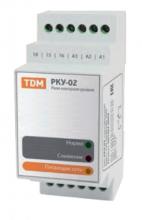
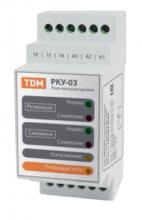
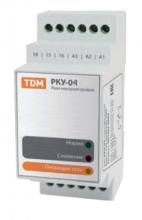
The operation of the relay is based on the conductometric method for determining the presence of liquid, which is based on the electrical conductivity of liquids and the occurrence of microcurrent between the electrodes. The relays have changeover contacts, allowing the use of fill or drain mode. Supply voltage RKU-02, RKU-03, RKU-04 – 230V or 400V.
Scheme for controlling a pump in a tank in the “filling or draining” mode.

Scheme of pumping liquid from a well/reservoir to a reservoir, level control in both media, i.e. the relay performs a protective shutdown of the pump in dry running mode (when the liquid level in the well/reservoir decreases)
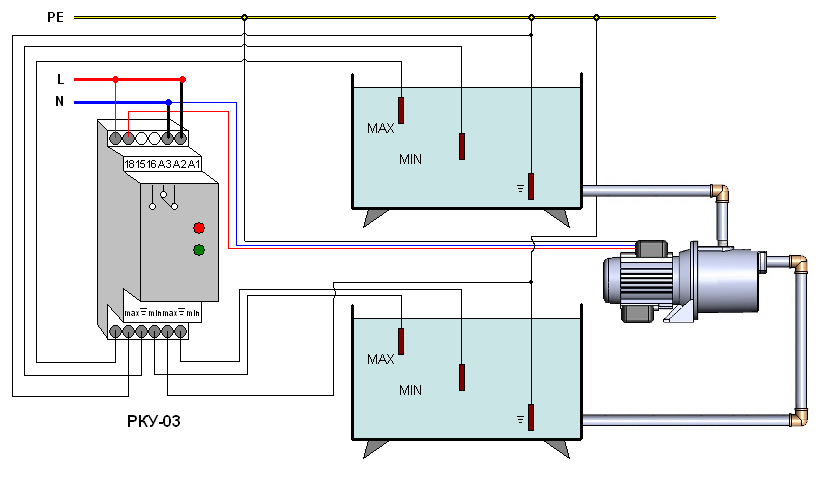
Scheme of alternating or total activation of 2 pumps. The RKU-04 relay is used in places where overfilling of wells, pits, catch basins and other containers is unacceptable. The relay works with 2 pumps, and, for uniform use of their resource, the relay switches them on alternately. In the event of an emergency, both pumps are switched off simultaneously.
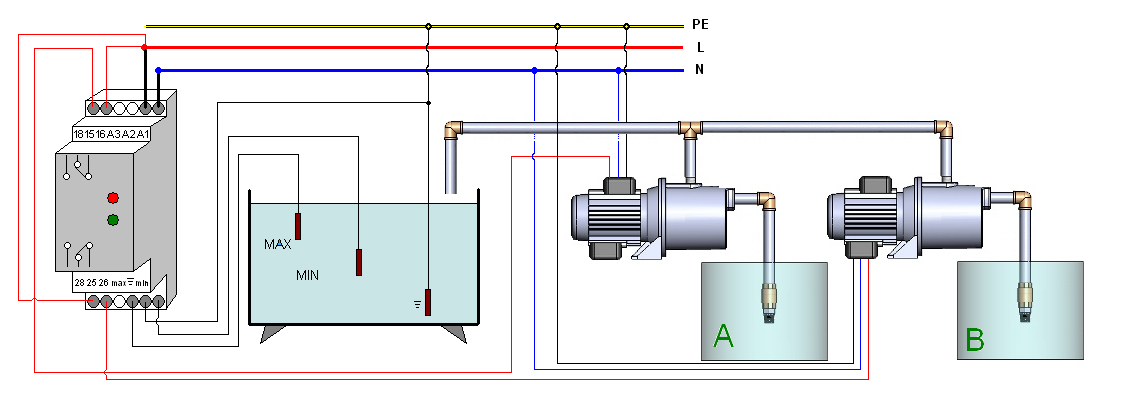
The relay cannot be used for the following liquids: distilled water, gasoline, kerosene, oil, ethylene glycols, paints, liquefied gas.
Comparative table of analogues by series:
| TDM | F&F | lovato | RiA |
|---|---|---|---|
| RKU-01 | PZ-829 | LVM20 | RKU-1M |
| RKU-02 | PZ-829 | LVM20 | RKU-1M |
| RKU-03 | - | LVM20 | EBR-02 |
| RKU-04 | - | LVM20 | - |
To regulate and control the level of liquid or solid substance (sand or gravel) in production or at home, a special device is used. It is called a water level sensor (or other substance of interest). There are several varieties similar devices, significantly different from each other in their operating principles. How the sensor works, the advantages and disadvantages of its varieties, what subtleties you should pay attention to when choosing a device, and how to make a simplified model with a relay with your own hands, read in this article.
The water level sensor is used for the following purposes:
Possible methods for determining tank load
There are several methods for measuring liquid level:
- Contactless– often devices of this type are used to control the level of viscous, toxic, liquid or solid, granular substances. These are capacitive (discrete) devices, ultrasonic models;
- Contact– the device is located directly in the tank, on its wall, at a certain level. When the water reaches this indicator, the sensor is triggered. These are float, hydrostatic models.
Based on the principle of operation, the following types of sensors are distinguished:
- Float type;
- Hydrostatic;
- Capacitive;
- Radar;
- Ultrasonic.
Briefly about each type of device

Float models are discrete and magnetostrictive. The first option is cheap, reliable, and the second is expensive, complex design, but guarantees an accurate level reading. However, a common disadvantage of float devices is the need for immersion in liquid.
Float sensor for determining the liquid level in the tank
- Hydrostatic devices – in them all attention is paid to the hydrostatic pressure of the liquid column in the tank. The sensitive element of the device senses pressure above itself and displays it according to a diagram to determine the height of the water column.
The main advantages of such units are compactness, continuity of operation and affordability. But they cannot be used in aggressive conditions, because they cannot do without contact with liquid.
Hydrostatic liquid level sensor
- Capacitive devices – plates are provided to control the water level in the tank. By changing the capacity indicators, you can judge the amount of liquid. Lack of moving structures and elements, simple circuit devices guarantee durability and reliable operation of the device. But one cannot fail to note the disadvantages - this is the necessity of immersion in liquid, and demanding temperature conditions.
- Radar devices – determine the degree of water rise by comparing the frequency shift, the delay between the radiation and the achievement of the reflected signal. Thus, the sensor acts as both an emitter and a reflection collector.
Such models are considered the best, accurate, reliable devices. They have a number of advantages:

The only disadvantage of the model is its high cost.
Radar tank liquid level sensor
- Ultrasonic sensors – the principle of operation and the design of the device are similar to radar devices, only ultrasound is used. The generator creates ultrasonic radiation, which, upon reaching the surface of the liquid, is reflected and reaches the sensor receiver after some time. After some mathematical calculations, knowing the time delay and speed of the ultrasound, the distance to the water surface is determined.
The advantages of a radar sensor are also inherent in the ultrasonic version. The only thing is that the indicators are less accurate and the operation scheme is simpler.
Subtleties of choosing such devices
When purchasing a unit, pay attention to the functionality of the device and some of its indicators. The most important questions when purchasing a device are:

Options for sensors for determining the level of water or solids
DIY liquid level sensor
You can make a basic sensor to determine and control the water level in a well or tank with your own hands. To perform the simplified version you need:

A self-made device can be used to regulate water in a tank, well or pump.
In industry and everyday life, there is always a need to determine various levels in containers. Level sensors are used for these tasks various designs. Depending on the filling environment of the tank, one or another sensor is used; sometimes, for the sake of simplicity and saving money and time, combined sensors are used, that is, made by hand. These are simple designs that use completely different types of sensors. Basically, such sensors are used where there is no easy access to the measurement environment or the measurement location is very aggressive for human health.

Most modern level sensors have in their design electronic relay with converter. The electronic circuit is designed to convert the measured value into a standard signal. The signal can be analog or discrete. Analog can be a current 0..20mA and a signal called a current loop 4..20mA or a voltage 0...5V, 0..10V.
Level sensors are used to protect the pump motor from dry running, regulate the motors of well pumps that fill any containers with water and more in the cold and hot water supply system.
DIY water level sensor
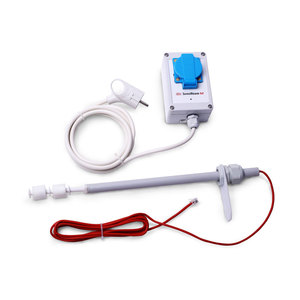 Let's see, using the example of pumping water from a pit, how we can control the automatic cycle of maintaining the water level not higher than the required one.
Let's see, using the example of pumping water from a pit, how we can control the automatic cycle of maintaining the water level not higher than the required one.
We have a pit with a very dirty-looking liquid consisting of water and impurities of coolant for the cutters of a metal-cutting machine.
All types of sensors were considered, however, in terms of price and ease of implementation, they were suitable combined design, consisting made of wire three meters long(depth of the pit), attached to a float (large plastic container with air), on the surface the wire is attached to a spring with a petal.
The signal is taken as a normal discrete 24V signal from a regular inductive sensor. He works on the petal. When the water level in the pit rises, the float rises, weakening the spring. A petal is attached to the end of the spring; it rises due to the extension force of the spring. The petal, in turn, receives feedback from the inductive sensor, feeding the pump motor relay to the coil, causing it to pump out water from the pit. In order to avoid frequent switching on and off of the engine, in the sensor-coil circuit there is a switch-off delay relay set to 10 minutes.
Thus, the next time the sensor is triggered, the relay will work again and the cycle will repeat.
Of course, to protect the engine from dry running it is advisable install a leakage sensor in the pipe, through which the emulsion is pumped out. But in our case, simplicity of design was important. Instead of an inductive sensor, you can use two plates in contact with each other, which will be even more economical.
If water or other liquid has a homogeneous composition, then a metric single-electrode level sensor can be used.
For example, DU-1N manufactured by Relsib, designed for measuring levels in various types liquids. The sensor can operate over a wide range temperature limits. The body is not subject to corrosion and is made of high quality stainless steel. Ceramic and fluoroplastic are used as insulation, this provides excellent insulating protection. Resistant to many mechanical loads. The measurements are independent of liquid density. And does not require additional care during operation.








